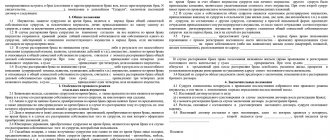Home » Division of property » How to divide common shared ownership of a land plot
10
Common shared ownership of two or more co-owners implies that each of them has the right to his share of the land and to use it, but none of them can dispose of the property independently from the other owners of the land plot. No one can sell, donate, or exchange their share, since it is not allocated in kind.
If there is a normal relationship between the co-owners, then this does not cause much trouble, but as soon as it comes to the division of property, for example, during a divorce, this type of property creates many problems for the co-owners. In this case, the only way out of this situation will be the division of a land plot that is jointly owned by actually allocating a share.
When does common shared ownership of a land plot arise?
The grounds for the emergence of common shared ownership may be:
- privatization of a land plot;
- entry into inheritance by two or more heirs;
- recognition by the court of common property rights;
- carrying out a legal transaction between citizens and legal entities (for example, the transfer or sale of land previously owned by a state or collective farm to a married couple).
Most often, plots of land that have a minimum permissible size in area are registered as common shared ownership, since registration of shared ownership does not require land surveying and division into shares; accordingly, the legal procedure is simplified.
To understand common shared ownership of a car and the problems associated with it, we can call it joint ownership of a vehicle. As long as everything is in order in the family, no questions arise, all co-owners use the car equally, but as soon as the question of dividing joint property arises, the car becomes a stumbling block. It cannot be divided in kind; you cannot sell half the car, you cannot give it away, you cannot drive half the vehicle.
Who can become a member of the section
In the vast majority of cases, the right of common ownership of land plots arises for a married couple after privatization or purchase of a plot of land. Much less often, the right of joint ownership appears in a group of persons who are not relatives, for example, when allocating land plots to a gardening partnership. In any case, according to the law, any land owner has the right to demand a division of land.
In fact, such a requirement means that any of the co-owners can demand the determination of his share and the actual separation of this share from the common property. After such an allocation, the remaining land will continue to be in common ownership of other owners (if there are several of them).
Land division options
But similar situations also happen. At the time of marriage, the husband owned a plot of land in the Moscow region. After several years of marriage, the couple decided to build a house on the site and move out of town for good. To do this, the wife sold her one-room apartment in one of the residential areas of the capital. At the time of the divorce, the family owned a large country house, but the husband categorically refused to divide the property, arguing that the plot where the residential building was erected was acquired by him before the wedding and there could be no question of any division.
My wife came to a lawyer with a question about how to divide this plot of land during a divorce. He, having assessed the situation, drew up a claim for division of property, attaching to it evidence that the woman had invested her own funds in the construction of the house and improvement of the site. Having considered the case materials, the court decided to divide the land plot and the buildings on it between the spouses in equal shares. The spouses were also given options for possible division of the subject of the dispute.
- Retain the land and house for one of the parties, who will pay the ex-spouse an amount equal to half the price of the property.
- In the event of a divorce, keep the land plot with the buildings on it for the spouse, and leave the city apartment and car as the property of the wife.
- Selling a plot after a divorce and dividing the amount received in equal shares.
Who is the defendant when dividing land in kind?
If the land plot is jointly owned by a married couple, then the defendant will be considered the one of the spouses against whom the demand for division of the plot of land is made.
For example, if a husband decides to allocate his share of a joint plot in kind, then his wife will be the defendant.
In cases where several people are co-owners, all co-owners except the one who filed a demand for division will be defendants.
For example, a plot of land is the joint shared ownership of members of a gardening partnership. One of them decided to actually allocate his share of the land. In this case, all other owners of the land plot will become defendants.
Judicial division
If there is a misunderstanding between the owners regarding the issue of dividing common shared property, the only legal way to carry out this procedure is through litigation.
The main feature of this procedure is that to allocate a share from a land plot, the will of only one of the participants is sufficient. Thus, if the owners of real estate cannot come to an agreement, any of them has the right to file a corresponding statement of claim in court.
The size of the land plot when dividing the land plot
When dividing any land plot in accordance with the law, it is necessary to fulfill the condition that the area of each of the newly formed plots cannot be less than that established for a certain category of land in the region. To successfully carry out the division, it is necessary, first of all, to determine whether the plot of land planned for allocation in kind falls within the established minimum and maximum size limits.
In each region, the minimum and maximum allowable sizes are set by the local governments of these regions.
The maximum permissible minimum sizes in the Moscow region are:
- for running a peasant farm - 20,000 square meters or 200 acres;
- for setting up a garden - 600 sq. meters or 6 acres;
- for gardening - 400 sq. meters or 4 acres;
- for the construction of a summer house - 600 sq. meters or 6 acres.
Maximum allowable area:
- for running a peasant farm - 400,000 square meters or 4,000 acres;
- for setting up a garden - 1500 sq. meters or 15 acres;
- for gardening - 1000 sq. meters or 10 acres;
- for the construction of a summer house - 2500 sq. meters or 25 acres.
Let's consider the possibility of dividing a jointly owned land plot using the example of the Moscow region.
There is a plot of land in the near Moscow region with an area of 800 square meters. meters, intended for the construction of a summer house. When dividing this plot in half, one or both secondary plots will a priori be smaller than the maximum permissible size in the region (600 sq. meters). The law prohibits the division of such land plots and the allocation of a share in kind.
Another variant. There is a plot of land with an area of 13 acres, intended for planting fruit trees (arranging a garden). The division will result in two secondary plots with an area of 6.5 acres each, which is within the maximum permissible minimum sizes for this category of land. The legislation allows the actual division of such a land plot.
Land Code
The procedure is regulated by the Land Code of the Russian Federation, the Federal Law on Real Estate Registration, and other legal acts.
- Art. 1 Federal Law No. 218 – general provisions, including clause 7 – cadastral registration.
- Art. 8 No. 218 “On state registration of real estate” – basic and additional information.
- Art. 11.4 RF Land Code – basic rules.
- Art. 11.9 of the Land Code of the Russian Federation - conditions, non-compliance with which will lead to a ban on delimiting land.
- Art. 26 Federal Law No. 218 – grounds for suspension of real estate registration.
- Other regulatory legal acts, for example, Art. 13 Federal Law No. 214 – on shared construction.
How to divide the land
The division of a land plot is possible in two ways:
- Voluntarily, by signing an agreement on the allocation of land in kind. This method is possible if the co-owners have normal relations and can solve the problem peacefully.
- Through litigation.
Voluntary section
A voluntary agreement on the division of shared ownership is concluded between all co-owners of the land plot and only if they all agree to the division. Notarization of this procedure is required.
The document is drawn up in free form, but it must contain the following information:
- personal data of all signatories of the agreement;
- address of the site to be divided;
- cadastral number of the primary land plot;
- confirmation that all co-owners agree to the division;
- place and date of signing the agreement.
Land surveying and obtaining new cadastral numbers of secondary land plots is possible only after submitting to the local government an agreement signed by all co-owners of the land plot and having it certified by a notary office.
When voluntarily allocating a share and actually dividing the land, the following algorithm of actions must be performed:
- Land surveying. In the process of this surveying, secondary plots are immediately registered in the cadastral register.
- Preparation of a plan for the allocated area and an act of approval of its boundaries.
- Submitting documents to the local municipality for plan approval.
- Registration of permission for the actual division in local governments.
- Submitting documents to the Registration Chamber and obtaining a certificate of ownership of the allocated land plot.
When contacting the Registration Chamber, you must have the following package of documents with you:
- title documents for the land plot;
- cadastral passport;
- consent of all co-owners of the land to the division.
Each owner of newly formed secondary plots must pay a state fee for obtaining a certificate of land ownership. The state duty is one thousand rubles.
Division of land in court
If the co-owners of the land plot were unable to peacefully resolve the problem of dividing their joint property, the initiator of the division has to file a claim in court.
There are situations when co-owners agree with the division, but concluding a voluntary agreement is not possible for some reasons, including the following situations:
- land surveying in any way affects the interests of third parties (not co-owners of the divisible plot);
- the boundaries of the divided plot have a complex configuration and the co-owners cannot agree on how it can be divided.
A striking example of how land surveying can affect the interests of third parties is the situation when a public road passes through the territory of the divided plot. None of the co-owners wants this road to pass through his actual share, since this creates certain inconveniences for the owner of the land. In such cases, the court:
- Will involve competent land managers to solve the problem for the optimal division of land between the co-owners.
- It will determine the procedure for using the disputed territory (in this case, the road). Most often, in such cases, the court transfers part of the disputed area to the management of the municipality.
The division of land in shared ownership through the court is permissible only if the size of the shares of each of the co-owners is taken into account. The exception is when one of the co-owners pays monetary compensation to the other in exchange for transferring ownership of the entire plot to him.
The actual forced division (through the court) occurs according to the following algorithm:
- The initiator of the division determines the size of the share of each of the co-owners, and the number of shares must be equal to the number of co-owners.
- The plaintiff draws up and submits a statement of claim to the court, where he demands that he be allocated an actual share of the joint property.
- The court schedules a trial in which, after analyzing all the evidence, it considers the possibility of dividing the property. If actual division is possible, the court makes a positive decision.
- After receiving a court decision, the co-owners of the plot apply to the Registration Chamber with a document in order to formalize new ownership rights to the secondary plots.
The initiator of the division of shared ownership must keep in mind that only those plots are subject to division, the division of which creates secondary plots that comply with the standards for the minimum established size, that is, the newly formed land plots should not be less than the minimum established area.
If the size of the allocated plot is less than the established standard, the court will refuse to satisfy the claim.
In cases where the land plot is recognized as indivisible, the court determines the procedure for using the disputed plot. A special scheme is drawn up for dividing the allotment into separate plots according to the number of co-owners, each of which passes into the possession of each of the owners.
In this case, the land remains in shared ownership, but its co-owners have the right to fence off their part, place buildings on them, and use the land at their own discretion. But the owners still cannot sell, donate, or perform any other legal actions with their land.
Preparation of a statement of claim
Sample statement of claim for division of a land plot and allocation of a share in kind
The court's decision often depends on how complete and legally competent the statement of claim is drawn up. It should contain:
- Details of the court to which the plaintiff is filing the claim. It is necessary to respect the jurisdiction of the case; the claim is filed with the judicial authority of the municipality on whose territory the disputed site is located.
- Cost of claim.
- Information about all participants in the process.
- Data on the disputed plot: the procedure for acquisition, use, designation of the shares of each of the co-owners.
- The reasons why the plaintiff went to court, the steps that the plaintiff tried to take to eliminate the problem.
- The plaintiff’s claims with their justification and references to specific articles of the Law on the basis of which the plaintiff applies to the court.
- List of attached documents.
- Date of filing the claim.
- Plaintiff's signature.
The applicant must attach photocopies of all documents listed in the application to the claim.
It is necessary to keep in mind that in each specific situation this list will be different, therefore, when drawing up a claim, it is advisable to contact a competent lawyer who will help you write a statement and tell you what documents need to be attached in a particular case.
Some of the documents are required for each section option, these are:
- Copies of passports of each party to the process.
- Title documents for the original land plot.
- Cadastral passport of the land plot.
- All technical documents for the land.
- When conducting an independent assessment of the plot - a certificate of the value of the plot.
- Original receipt for payment of state duty.
The amount of the state duty depends on the price of the claim, which, in turn, is calculated on the share in the property that the applicant has plans for.
Table 1. Calculation of the state duty for a statement of claim for the division of land and the allocation of a share in kind, depending on the price of the claim.
| Property value, rub. | Deduction from the amount, rub. | Constant, rub. | State duty (percentage of property value, %) | State duty limit, rub. |
| Up to 20,000 | — | — | 4 | Not less than 400 |
| 20 001—100 000 | 20,000 | 800 | 3 | — |
| 100 001—200 000 | 100,000 | 3,200 | 2 | — |
| 200 001—1 000 000 | 200,000 | 5,200 | 1 | — |
| Over 1,000,000 | 1,000,000 | 13,200 | 0.5 | No more than 60,000 |
State duty, expenses
When dividing a land plot, the plaintiff must calculate and pay a fee in the amount determined on the basis of Art. 333.19 of the Tax Code of the Russian Federation on the rules for assessing property claims.
To determine the amount of the fee, you can take both the value of the site determined during the assessment and the cadastral value.
Example. The cadastral value of the plot declared for division is 700,000 rubles. The plaintiff asks to oblige the second spouse to pay her compensation in the amount of half the cost of the plot, that is, in the amount of 350,000 rubles.
To calculate the duty in this case, the rule will be used for claims with a price from 200,001 rubles to 1 million in Art. 333.19 Tax Code of the Russian Federation.
- 5,200 rubles (fixed rate) + 1,500 rubles (1% of the amount exceeding 200 thousand rubles) = 6,700 rubles.
If the claim claims other property for division, the fee will be calculated based on the price of the claim in the form of the value in the share of the property claimed by the plaintiff.
For more information about the procedure and features of calculating state duty when dividing property, read this article.
In addition to the fee, the plaintiff may have to incur the following costs for dividing the land plot:
- lawyer's fees;
- payment for land management examination;
- payment for assessment;
- payment for the work of cadastral engineers.
Only an experienced lawyer can determine the exact list of expenses that will have to be incurred in a given situation.
Arbitrage practice
If you look at the statistics of court decisions on the actual division of shares of land plots, the main grounds for division are the division of land plots:
- inherited by a group of persons;
- during divorce and division of joint property;
- if one of the co-owners intends to sell or donate his share, leave it as collateral, or carry out other legal procedures.
The division of joint shared ownership of any real estate property is a rather complex process, which becomes many times more complicated if there is a division of a land plot that is jointly owned. Here, in addition to maintaining equality of parties, it is also necessary to take into account the minimum and maximum permissible sizes of secondary land plots; often third parties who have their own interests in the divided area are included in the process.
The likelihood of incorrect actions and annoying mistakes that complicate the process, and sometimes completely eliminate the further implementation of the division procedure, is high.
Therefore, all lawyers strongly recommend, at least at the first stage, to contact a competent lawyer who will tell you:
- what documents are required for the section,
- algorithm of actions;
- what mistakes should be avoided.
A lawyer will help you write a statement of claim, become your confidant when visiting authorities and in court proceedings, and, if necessary, help you challenge the court decision if it does not suit you.
FREE CONSULTATIONS are available for you! If you want to solve exactly your problem, then
:
- describe your situation to a lawyer in an online chat;
- write a question in the form below;
- call Moscow and Moscow region
- call St. Petersburg and region
Save or share the link on social networks
- FREE for a lawyer!
Write your question, our lawyer will prepare an answer for FREE and call you back in 5 minutes.
By submitting data you agree to the Consent to PD processing, PD Processing Policy and User Agreement
Useful information on the topic
6
Statement of claim for divorce and division of property
If, upon divorce, the former spouses cannot agree on...
2
Valuation of property when dividing marital property
When dividing property, spouses are often faced with the fact that they...
1
Division of property of an individual entrepreneur during divorce
An individual entrepreneur (IP) is an individual who runs his own...
5
Division of inheritance in case of divorce between spouses
Article 36 of the Family Code of the Russian Federation states that property received...
6
Division of gifted property during divorce
In the process of divorce, almost every married couple faces...
1
Joint will of spouses
The legislation of the Russian Federation prohibits citizens from leaving joint wills, regardless of...










